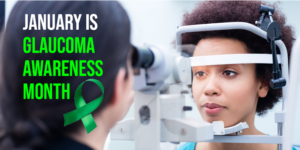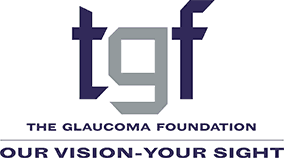~January is Glaucoma Awareness Month, Let’s Dispel Some Myths ~

Have you made a resolution to have your eyes checked for the new year? Early diagnosis and treatment are key to controlling this “sneak thief of sight.” The notion that people can tell if they’re developing glaucoma is one dangerous myth about the disease. Here are some others.
Myth 1: Your vision will deteriorate or blur if you are developing the disease.
Most forms of glaucoma have no symptoms or cause no change in vision until later in the course of the disease. Once vision has been lost to glaucoma, permanent damage has already been done to the optic nerve and sight cannot be restored.
Myth 2: Only old people get glaucoma.
Though frequency increases with age, glaucoma can strike at any time in a person’s life. Approximately one in 10,000 babies is born with glaucoma.
Myth 3: Glaucoma is always inherited?
Family history is a strong risk factor for glaucoma but an absence of family history does not mean a person is risk-free. If there is a family history, everyone in the family – from children on up – should be tested.
Myth 4: Ethnicity has nothing to do with glaucoma risk.
Blacks and Asians are at particularly high risk for developing glaucoma. Researchers have also recently discovered that glaucoma is far more common among U.S. Hispanics than originally thought. African Americans are six times more likely to suffer from glaucoma than Caucasian Americans, and develop the disease years earlier, often with a greater rate of vision loss.
Myth 5: All people with glaucoma have elevated intraocular eye pressure.
Elevated eye pressure (IOP) is a risk factor for glaucoma and is not the disease itself. There are more than 40 different types of glaucoma, and not all are associated with elevated IOP. Glaucoma specialists believe that some forms of glaucoma are strongly related to vascular changes and impaired “nutrition” (poor blood flow) to the optic nerve. The common thread among all glaucoma is damage to the optic nerve rather than elevated IOP.
Myth 6: If you don’t have high blood pressure, you cannot have high eye pressure.
Blood pressure and eye pressure vary independently. Controlling blood pressure does not mean IOP is controlled. However, high blood pressure is often – but not always – associated with elevated IOP. Interestingly, low blood pressure is strongly associated with some forms of glaucoma such as normal-tension glaucoma.
Myth 7: Glaucoma always leads to blindness.
This is one of the most dangerous myths of all. Some 90 percent of all glaucoma-related blindness could have been prevented with proper treatment. If fact, glaucoma is the leading cause of preventable blindness. But you can’t get treated unless you know you have a problem! Make an appointment to have your eyes checked today.
